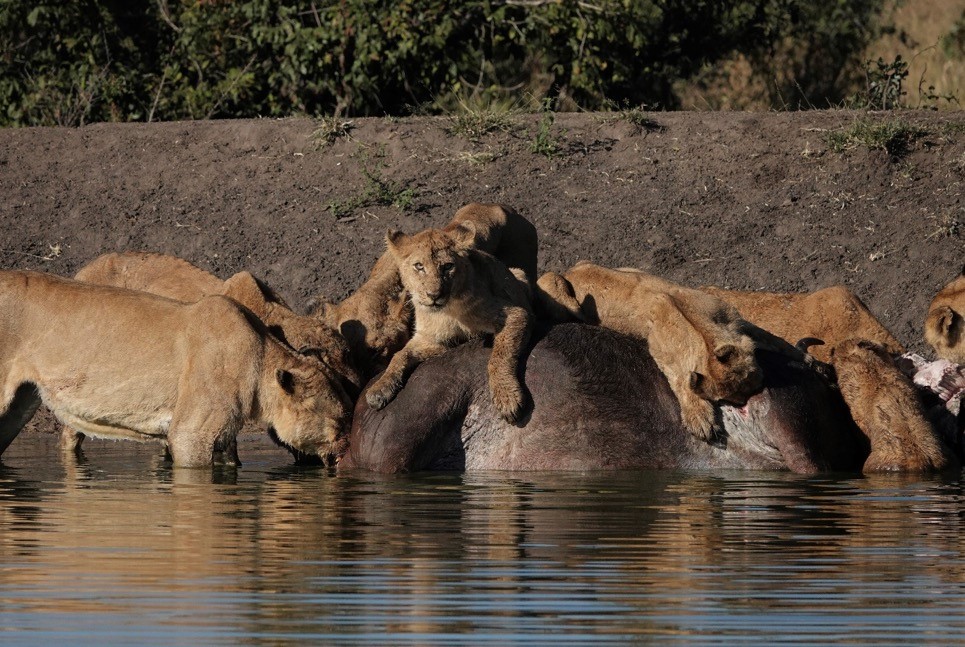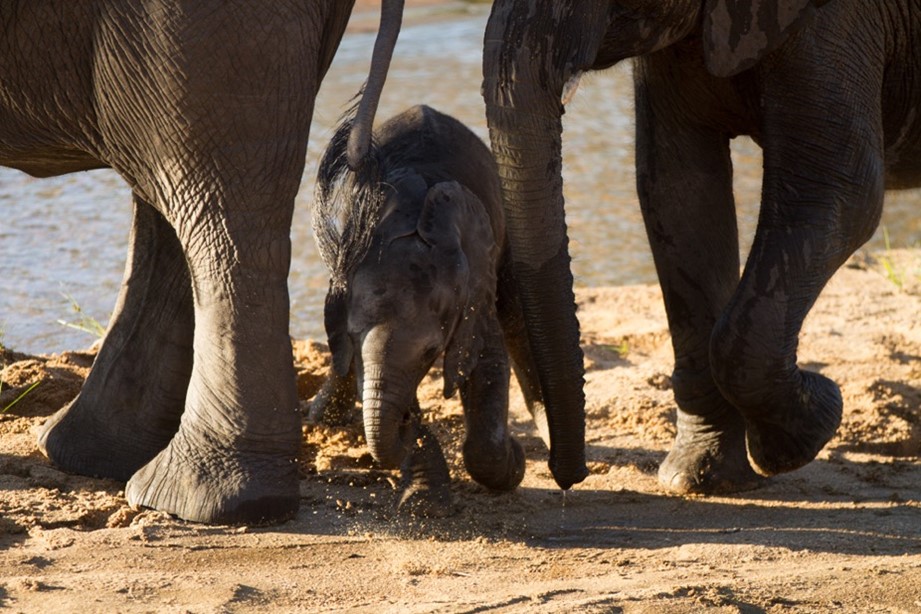May 2024
Singita Sabi Sand
Share:
Singita Sabi Sand: May 2024
The month of May can typically be summed up by the stillness of the late afternoon and the calmness of the star-filled night skies. However, this month while this atmosphere certainly was present, the wildlife took on a different approach with spectacular scenes unfolding in front of our guests that brought a heart-racing energy on the reserve. The multitude of interspecific competition - interaction between two different species, was quite remarkable and had us all on the edge of our seats.
The Mhangeni Pride was viewed 14 days in a row as they scavenged off a dead hippo. Leopard viewing has been of superb quality and there have been numerous sightings daily of these graceful cats. The reserve is littered with massive herds of elephants and dazzles of zebras are penetrating right into the heart of Singita as they move to the Sabi Sand for the dry season. Each day has provided us with extraordinary opportunities to witness some of nature’s greatest displays and keeps us exploring for more.
Here's a sightings snapshot for May:
Lions

Fortune has been on the side of the Mhangeni Pride this month as they have managed to come across three easy meals in the form of two buffaloes that were found deceased in two different watering holes, as well as a hippo. This provided stable lion viewing throughout the month of May. The condition of the 15-year-old lioness has not improved as her muscles are starting to breakdown. Although difficult to see her in such a state she has had a successful life and her legacy speaks for itself.
The Tsalala lioness has her first litter of cubs somewhere close to Millennium koppies. The prominent suckle marks that are now visible on the lioness are a sure sign of new lion cubs. Let’s hope they survive and grow this pride which has been on the Sabi Sand since 1998.
In the western part of Singita we have had viewing of the two young Othawa lionesses. One such sighting we watched in amazement as a clan of five hyena cornered them in a riverbed where they then decided to climb a tree to get out of reach from the hyenas.
The Plains Camp lions have been causing quite a stir in the northern parts of Singita and surrounds as they have been driving out young males from the Nkuhuma and Talamati Prides.
Cheetah
The female cheetah that has been seen for the past two months throughout Singita looks to be pregnant. The southern grasslands have been a chosen denning area for female cheetahs before and there is good chance she will choose this area. If she does, it may indicate that the male that patrols the south is likely to be the father.
Leopards
The south-eastern part of Singita has seen seven different leopards moving through that area of the reserve. One of many highlights relating to leopards in that area was when the Nlanguleni female scavenged a kill from the Ntomi male and then proceeded to follow him around for a few days while trying to entice him to mate with her. On this day the Nkuwa female, the Nlanguleni female’s daughter, was sighted with her two older cubs. The Senegal Bush male was also in the area meaning the whole family tree for those three generations were viewed just a few miles apart.
The Xipuko male had a hoisted impala kill off of 40 km Pan as he now moves much further south and west as the older Senegal Bush male has pushed him out of the area surrounding Castleton. This has resulted in the increase of leopards moving about in this area as the unrelated male, Xipuko, is pushed out.
To the west of Ebony Lodge, the Thamba male has been a frequent presence in the riverine forest. Like many of the other leopard sightings this month he too was seen feeding on an impala ram which he had stashed in a low branch of a russet bushwillow tree in a dry riverbed. Merely five minutes from camp this was a fantastic find for our guests.
The Kangela male leopard has made brief appearances as he avoids the larger males that have a stronghold on most of Singita’s section of the Sabi Sand. He was reminded of his place in the hierarchy when shortly after making a kill and dragging it up a tree the Hlambela male burst onto the scene, fought with the younger male and accidentally dislodged the impala carcass from the tree to the hyenas waiting below.
Wild dogs
The pack of three are denning with their pups in the southern parts of our traversing area. The pups are still too young to be viewed by vehicles and a five-week period of no viewing at the den has been put in place. According to research pups that are only viewed after the first five weeks have a far greater survival rate as the pups stay in the one den for longer.
The Toulon pack of 11 wild dogs have been seen hunting to the north and south of the Sand River. One afternoon the valiantly defended their grey duiker kill from a clan of seven spotted hyenas.
The Othawa pack of seven has one female that is close to giving birth. Last year they denned to the north of our lodges and had a total of twenty-four pups where both the beta and alpha females’ pups were raised in one den. Will history repeat itself once again for this pack?
Elephants

For many of our guests of late the elephants have been a firm favourite as they are always a welcome sight, no matter how many times we find them on a safari. In the wooded areas of Singita a snapping branch is never too far away as the elephants supplement their diet with cambium and roots of trees. We have enjoyed mild to warm temperatures by midday meaning the elephants are never far from the Sand River.
Buffaloes
As the dry season is well and truly underway the daily pilgrimage to big bodies of water by the buffalo herds are captivating to say the least. As the herd approaches the water’s edge so the pace picks up and one can hear the thudding of hooves in the surrounds. Dust and oxpeckers fill the sky as the head of the herd finally reaches the watering hole, a feast for the senses.
Unusual Sightings
Andries and Howard had a special sighting of an African clawless otter at Pios Crossing, hunting for crabs and other molluscs in the rapid. Sightings of these shy creatures are always treasured for guides and guests alike.
We have seen a pair of secretary birds that on a few occasions have been seen inspecting large thorny trees for possible nesting sites. This would be a fantastic addition to the reserve if they do breed here.
In the north Andrew and Louis found a hyena den while looking for wild dogs, at least three cubs from two litters have been seen at the entrance to the den. The clan of adults is well over ten in this area.
Bird List
The bird list for May includes four new species, bringing our bird list for the year up to 270 birds. Specials for the month included a pair of secretary birds, a glossy ibis and a couple of sightings of a half-collared kingfisher along the Sand River.